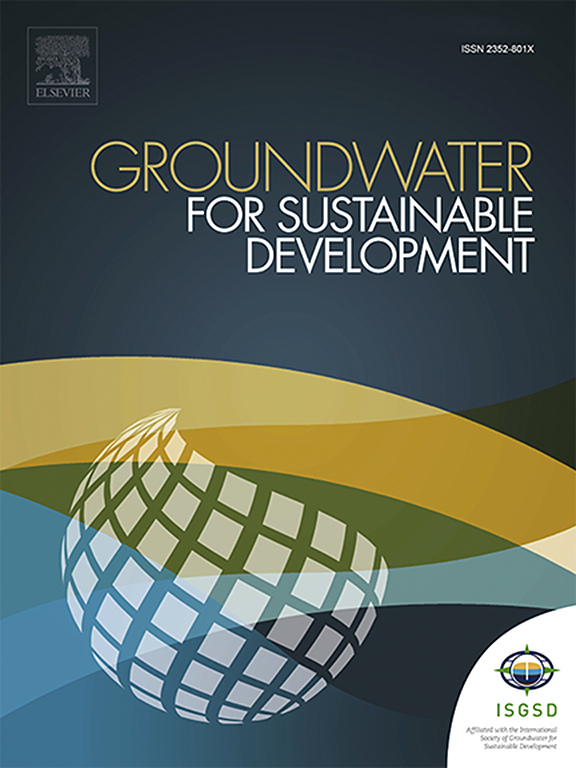基于卫星的水资源核算+ (WA+)框架在印度半干旱河流流域估算地下水平衡和利用的实施
IF 4.9
Q2 ENGINEERING, ENVIRONMENTAL
引用次数: 0
摘要
本研究应用了基于卫星的Water Accounting Plus (WA+)框架,其中使用WaterPix模型(基于像素的水文模型)和Budyko假设,根据独特的基于WA+的土地利用(WALU)类别,来解释印度干旱易发的戈达瓦里河中部流域(CGRB)的地下水平衡和利用。在研究期间(2003-2020年),地下水储存量减少了2.59 km3/年,尽管抽取了8.88 km3/年,而总补给量为13.4 km3/年,其中12.22 km3/年来自垂直补给,1.18 km3/年来自地下水回流(如灌溉)。这可能是由于补给地下水对基流的贡献率较高(约54%)。基流的高贡献表明CGRB的地表水-地下水相互作用强,流域的生态健康主要由基流维持。利用流域内26口观测井的地下水位数据验证了地下水负储量变化的正确性。此外,水需求(ETBlue + ETGreen)高于供水,导致大部分地区的CGRB缺水。ETBlue对灌溉作物耗水量的测量表明,大部分取水(约95%)来自地下水,这表明该盆地对地下水资源的严重依赖。因此,ETBlue的热点地区(尼扎马巴德、尼尔马尔、辛戈里、南兰德的部分地区、奥兰加巴德和帕尔巴尼)将被优先考虑,以减少地下水抽取,并将“热点”变成“亮点”。ETBlue热点地区的农民应该种植需水量较少的作物(通过作物多样化),例如小米和其他粗粮,以减少农业用水。最后,利用WA +框架对地下水供用进行可靠量化,有助于数据稀疏地区的地下水资源管理。本文章由计算机程序翻译,如有差异,请以英文原文为准。

Implementation of satellite-based water accounting plus (WA+) framework for estimating groundwater balance and utilization in a semi-arid river basin of India
This study applied the satellite-based Water Accounting Plus (WA+) Framework wherein a WaterPix Model (pixel-based hydrological model) along with the Budyko hypothesis was used to account for the groundwater balance and utilization in the drought-prone Central Godavari River Basin (CGRB) of India as per the unique WA + based Land Use (WALU) classes. A reduction of 2.59 km3/year in the groundwater storage was observed during study period (2003–2020) despite the withdrawals of 8.88 km3/year against the total recharge of 13.4 km3/year, of which 12.22 km3/year was received from vertical recharge and 1.18 km3/year as the return flow (e.g., irrigation) to the groundwater. This may be attributed to the higher percentage contribution (∼54%) of the recharged groundwater to the baseflow. The higher baseflow contribution shows that surface water (SW)-groundwater (GW) interaction in the CGRB is high, and the ecological health of the basin is primarily sustained by the baseflow. The negative storage change in groundwater was also validated with the groundwater level data collected from 26 observational wells across the basin. Moreover, water demands (ETBlue + ETGreen) were higher than the supplied water, resulting water scarcity in the CGRB for most of the districts. The consumptions from ETBlue that is a measure of water consumption from irrigated crops suggests that the majority of water withdrawals (about 95%) originate from groundwater, revealing the basin's heavy reliance on this resource. Therefore, the marked ETBlue hotspots (Nizamabad, Nirmal, Hingoli, parts of Nanded, Aurangabad, and Parbhani) are to be prioritised for reduced groundwater withdrawals and making ‘hotspots’ to the ‘bright spots’. The farmers of the ETBlue hotspots regions should adopt less water-requiring crops (through crop diversification), such as millets and other coarse cereals to reduce water use in agriculture. Finally, the reliable quantification of groundwater supply and consumption using the WA + Framework can assist in groundwater resources management of a data sparse region.
求助全文
通过发布文献求助,成功后即可免费获取论文全文。
去求助
来源期刊

Groundwater for Sustainable Development
Social Sciences-Geography, Planning and Development
CiteScore
11.50
自引率
10.20%
发文量
152
期刊介绍:
Groundwater for Sustainable Development is directed to different stakeholders and professionals, including government and non-governmental organizations, international funding agencies, universities, public water institutions, public health and other public/private sector professionals, and other relevant institutions. It is aimed at professionals, academics and students in the fields of disciplines such as: groundwater and its connection to surface hydrology and environment, soil sciences, engineering, ecology, microbiology, atmospheric sciences, analytical chemistry, hydro-engineering, water technology, environmental ethics, economics, public health, policy, as well as social sciences, legal disciplines, or any other area connected with water issues. The objectives of this journal are to facilitate: • The improvement of effective and sustainable management of water resources across the globe. • The improvement of human access to groundwater resources in adequate quantity and good quality. • The meeting of the increasing demand for drinking and irrigation water needed for food security to contribute to a social and economically sound human development. • The creation of a global inter- and multidisciplinary platform and forum to improve our understanding of groundwater resources and to advocate their effective and sustainable management and protection against contamination. • Interdisciplinary information exchange and to stimulate scientific research in the fields of groundwater related sciences and social and health sciences required to achieve the United Nations Millennium Development Goals for sustainable development.
 求助内容:
求助内容: 应助结果提醒方式:
应助结果提醒方式:


